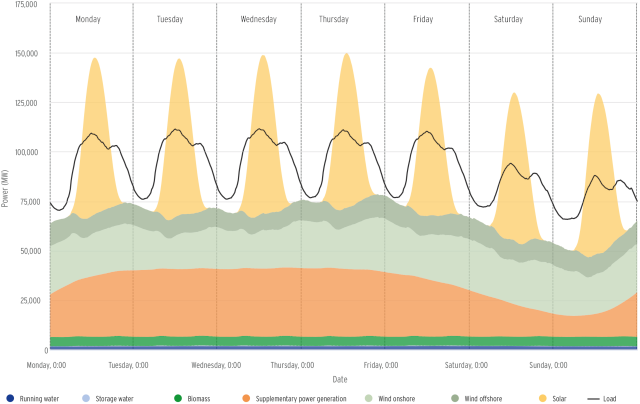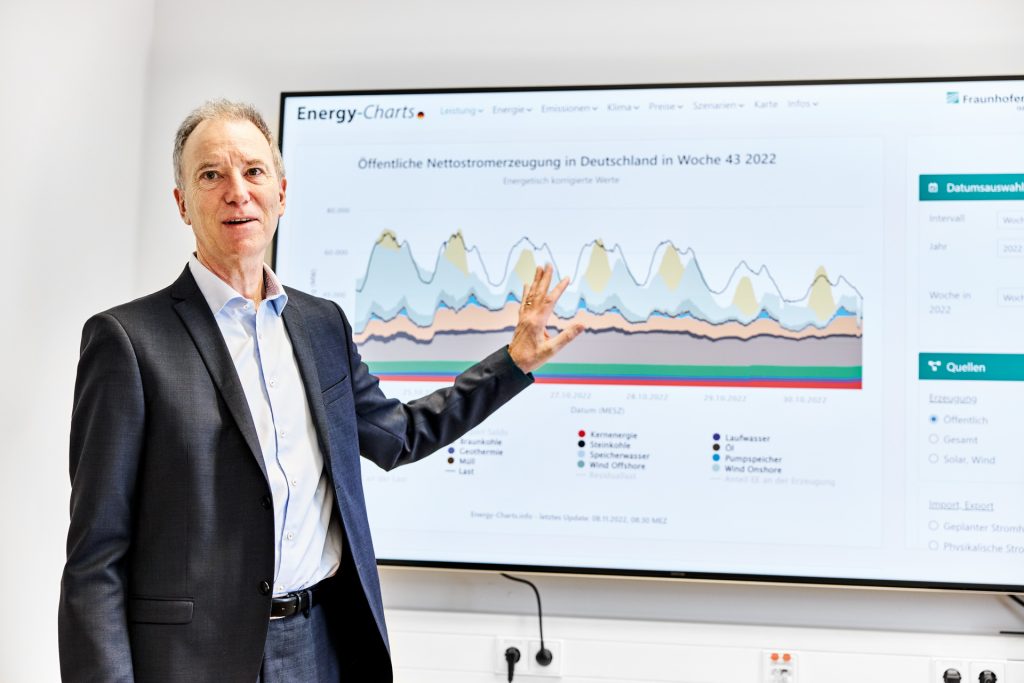No energy transition without short-term storage: Professor Bruno Burger from Europe’s largest solar research institute explains why experts agree on this point.
Professor Burger, the energy turnaround is now to move ahead rapidly. In the German government’s “Easter Package,” it was decided to expand solar and wind energy to 360 GW by 2030. Can the power grids even absorb this amount without additional storage capacities?
No. We need more transport capacity from north to south and, above all, we need lots of battery storage by 2030.
Why is battery storage so important for the future of grids?
Let’s take a look at the electricity consumption of an average week in 2030. It becomes clear that we will need more storage than before because during the day, generation is greater than load due to solar feed-in. This means that we need to store electricity at midday, which we then consume at dinner time; and at night, we can store wind power that is then available to us at breakfast. So the storage has two cycles a day. This is the perfect application for a battery.
Are there no alternatives to battery storage such as pumped storage power plants or electrolyzers?
Since we will mainly need short-term storage up to 2030, pumped storage would be an alternative. However, we do not have sufficient resources for this, at least not in Germany and there are only a few possible sites for new construction. And even if we expand them, that would still be far from sufficient for the energy transition.
Hydrogen will not play a role until 2030. Only then will we have significant surpluses to start producing it. However, we should not convert the green hydrogen back into electricity, which would generate losses again, but rather use it directly in industrial processes to make its use as efficient as possible. In this respect, electrolyzers will only play a role in the energy industry in the medium term.
„By 2030, we will need around 250 GWh of battery storage. As of today, we have 4 GWh.“
What volumes are we talking about? How great is the need for storage in the grids?
For our forecasts, we simulated the energy transition up to 2045 on an hourly basis and used this to calculate the demand for battery storage. By 2030, we will need around 250 GWh of battery storage. As of today, we only have around 4 GWh so these are huge dimensions that are coming our way.
Which network levels are mainly affected by this expansion?
This will take place at all grid levels—from grid boosters with up to 250 MW to small PV storage units in private homes with 5 kW. However, grid boosters have a special position. They belong to the transmission system operators and are therefore not allowed to participate in the electricity market according to current regulations. This means that they are only used in the event of faults or grid bottlenecks to avoid redispatch measures. It’s really a pity that such huge investments are only allowed to perform a few tasks and are not permanently in use. It would make more sense to change the regulatory framework and open up these capacities to the electricity market.
There are already many approaches for renewable power plants. In this way, operators can circumvent restrictions applicable to grid connections. Battery storage can be used to install more power and better adapt the generation curve to the available grid capacities. Coupled solar and wind parks with battery storage could then offer more or less reliable generation and market it accordingly.
“A significant portion of renewables are being fed into low voltage.“
A large part of the energy transition will take place in the distribution networks. What does it look like there?
Yes, the distribution grids are particularly affected. By 2030, for example, the German government wants to expand onshore wind power to 115 GW and solar to 215 GW. A great deal of this will be locally dispersed. Especially in the south, there will be no large wind farms, but rather individual systems that will then feed into the distribution grid. And solar is also largely found on roofs. This means that a significant proportion of renewables will be fed into the low-voltage grid.
What role do battery storage systems play at this level?
Private households can use battery storage to save their solar power generation throughout the day for the high-consumption evening hours. Instead of feeding the electricity into the grid for a low feed-in tariff (currently this is 8.2 cents/kWh for new installations), they can consume it themselves and currently save themselves 30 to 40 cents per kWh in purchasing costs.
Energy-Charts

On the interactive website developed by Prof. Bruno Burger, users can freely configure all graphics on electricity production, and electricity market prices in all countries of Europe. The site is fed by a variety of neutral and always up-to-date sources and wants to contribute to more transparency and an objectification of the discussion about the energy transition.
What about the batteries of electric cars? There is always talk here of crowd concepts. Do you think that’s a realistic option?
This is not just an option. It is a must! Because if we have fluctuating generation, we should adjust the loads to the generation if possible. It is always cheaper to consume electricity directly than to store it and consume it with a time lag. So, as a first step, it is important that we have controllable loads that increase electricity consumption when there is a lot of renewable energy available. That means, for example, that you go to work in the morning and expect your battery to be full by the evening. What happens in the meantime—whether charging stops, what power is used for charging—doesn’t matter. This is all left to a control system.
Concepts to integrate batteries bidirectionally and then to compensate the customer for this service are more difficult. This raises the question of who is responsible for control and remuneration? Do the distribution network operators have access to all charging stations and wallboxes, or should the manufacturers of the electric cars instead do this?
“Higher prices would be an incentive to better match consumption to generation. So there’s already a strong case for investing in energy storage across the board.”
Will car manufacturers thus become participants in the electricity market?
Yes, because the manufacturers already have communication interfaces to their vehicles and customers. They are in constant contact with cars, for example, to upload software updates and the like. These interfaces could also be used to control the charging of the batteries. The manufacturer, Volkswagen for example, could pool this function and thus control the charging of the entire fleet depending on market electricity prices, so that renewable energies are used optimally. It could also charge the electricity costs directly to the customer, which would be a simpler solution than controlling it via the wallbox.
Who are the battery storage operators and how are they financed?
The grid boosters are financed by a levy on the grid fees. Otherwise, anyone will build storage facilities for whom it pays off. The private citizen, because he produces solar power for 6 cents per kWh and saves 40 cents; and it is also interesting for companies. If they have high electricity prices and store their own generation in such a way that it fits better with consumption, then that is already an argument. If a company doesn’t have its own generation, it can use storage to lower peak prices or purchased-power levels. This is also of interest for municipalities and public utilities. There are more and more applications where battery storage pays off.
What then stands in the way of expansion with battery storage?
One important question, is how the electricity price zones within a network develop. Until four years ago, we still had a common electricity price zone with Austria. This meant that Austria bought its electricity when electricity prices were negative. That was always the case when we had a lot of wind in the north. But since the transmission lines from the North Sea to Austria had too little transport capacity, this was solved via redispatch. This means that the wind plants in the north were shut down and gas-fired power plants in the south had to start up and produce electricity for Austria at a negative price. Now, with the separate electricity price zones, this no longer happens. But we have this problem within Germany as well. For example, the common electricity price zone allows Bavaria to buy cheap wind power from the north, even though there is not enough transmission line capacity to transport it. Then gas-fired power plants have to start up in Bavaria and produce this electricity. And the costs for this are passed on to customers throughout Germany.
With different electricity price zones, electricity prices would be higher in southern Germany and lower in the north. What consequences would that have?
Electricity prices would probably vary seasonally because we have more wind energy in the north and more solar energy in the south. Higher prices would definitely be an incentive to better match consumption to generation and to store more electricity. So there is already a strong case for investing in energy storage across the board to support the further expansion of renewables
ABOUT THE PERSON

Prof. Bruno Burger is Senior Scientist at Europe’s largest solar research institute, Fraunhofer ISE, and creator of the Energy Charts.
